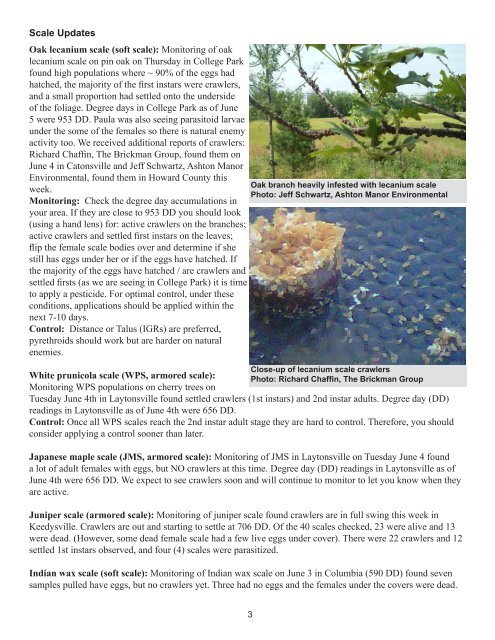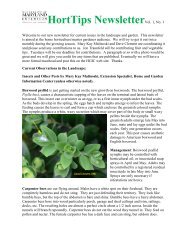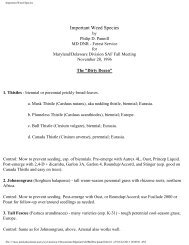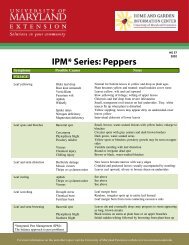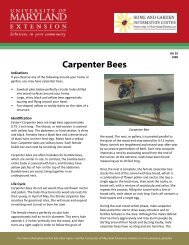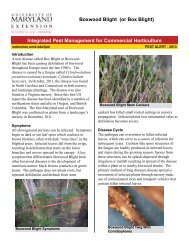13Jun07 - University of Maryland Extension
13Jun07 - University of Maryland Extension
13Jun07 - University of Maryland Extension
You also want an ePaper? Increase the reach of your titles
YUMPU automatically turns print PDFs into web optimized ePapers that Google loves.
Scale Updates<br />
Oak lecanium scale (s<strong>of</strong>t scale): Monitoring <strong>of</strong> oak<br />
lecanium scale on pin oak on Thursday in College Park<br />
found high populations where ~ 90% <strong>of</strong> the eggs had<br />
hatched, the majority <strong>of</strong> the first instars were crawlers,<br />
and a small proportion had settled onto the underside<br />
<strong>of</strong> the foliage. Degree days in College Park as <strong>of</strong> June<br />
5 were 953 DD. Paula was also seeing parasitoid larvae<br />
under the some <strong>of</strong> the females so there is natural enemy<br />
activity too. We received additional reports <strong>of</strong> crawlers:<br />
Richard Chaffin, The Brickman Group, found them on<br />
June 4 in Catonsville and Jeff Schwartz, Ashton Manor<br />
Environmental, found them in Howard County this<br />
week.<br />
Monitoring: Check the degree day accumulations in<br />
your area. If they are close to 953 DD you should look<br />
(using a hand lens) for: active crawlers on the branches;<br />
active crawlers and settled first instars on the leaves;<br />
flip the female scale bodies over and determine if she<br />
still has eggs under her or if the eggs have hatched. If<br />
the majority <strong>of</strong> the eggs have hatched / are crawlers and<br />
settled firsts (as we are seeing in College Park) it is time<br />
to apply a pesticide. For optimal control, under these<br />
conditions, applications should be applied within the<br />
next 7-10 days.<br />
Control: Distance or Talus (IGRs) are preferred,<br />
pyrethroids should work but are harder on natural<br />
enemies.<br />
White prunicola scale (WPS, armored scale):<br />
Monitoring WPS populations on cherry trees on<br />
Oak branch heavily infested with lecanium scale<br />
Photo: Jeff Schwartz, Ashton Manor Environmental<br />
Close-up <strong>of</strong> lecanium scale crawlers<br />
Photo: Richard Chaffin, The Brickman Group<br />
Tuesday June 4th in Laytonsville found settled crawlers (1st instars) and 2nd instar adults. Degree day (DD)<br />
readings in Laytonsville as <strong>of</strong> June 4th were 656 DD.<br />
Control: Once all WPS scales reach the 2nd instar adult stage they are hard to control. Therefore, you should<br />
consider applying a control sooner than later.<br />
Japanese maple scale (JMS, armored scale): Monitoring <strong>of</strong> JMS in Laytonsville on Tuesday June 4 found<br />
a lot <strong>of</strong> adult females with eggs, but NO crawlers at this time. Degree day (DD) readings in Laytonsville as <strong>of</strong><br />
June 4th were 656 DD. We expect to see crawlers soon and will continue to monitor to let you know when they<br />
are active.<br />
Juniper scale (armored scale): Monitoring <strong>of</strong> juniper scale found crawlers are in full swing this week in<br />
Keedysville. Crawlers are out and starting to settle at 706 DD. Of the 40 scales checked, 23 were alive and 13<br />
were dead. (However, some dead female scale had a few live eggs under cover). There were 22 crawlers and 12<br />
settled 1st instars observed, and four (4) scales were parasitized.<br />
Indian wax scale (s<strong>of</strong>t scale): Monitoring <strong>of</strong> Indian wax scale on June 3 in Columbia (590 DD) found seven<br />
samples pulled have eggs, but no crawlers yet. Three had no eggs and the females under the covers were dead.<br />
3


